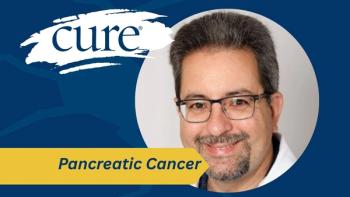
Role of the Pathologist
Transcript:
Philippa Cheetham, MD: Dr. Horn, you touched earlier on the importance of a pathologist who’s a part of these meetings, and they often put up slides that look like wallpaper to the rest of us. We’re not used to interpreting what these cell types mean, and we have to take their word that these cells are either aggressive tumor cells or not. How important is it, do you think, to have the pathologist there presenting what they see of the tumor under the microscope?
Leora Horn, MD, MSc: I think it’s very important. I think the pathologist gives us an idea in terms of staging the cancer. And, to be honest, the more wallpaper you see, the more familiar it becomes. So sometimes, the pathologist can put a slide up there and I almost know what it is. But having our pathologist right there, it really just makes them more a part of our team, so that when you are calling them with questions, they know who you are. You know who you’re talking to.
Philippa Cheetham, MD: They’re not just the invisible man behind the desk in the pathology lab.
Leora Horn, MD, MSc: Exactly. And I think that really makes a big difference in terms of communication, because we’re all there to treat the patients.
Philippa Cheetham, MD: Now, we know that in medicine and managing cancer in particular, there’s a huge human factor to it. The pathologist is a human. It’s their interpretation of what the cells look like under the microscope. Dr. Sandler, you’re a human being looking at imaging, giving your opinion. We all weigh in with our own opinions on how cancer should be treated, although more and more we’re trying to use national guidelines. The pathologist is a human being. They’re looking at these tissues under the microscope. I have 2 questions for both of you. Number 1, at Vanderbilt, is the pathologist who’s looking at the tissue somebody who is specializing in lung cancer? Or are they pathologists who look at all tissue? Is that important? And number 2, where do these new molecular markers in tissue come into the report that these pathologists provide to clinicians like yourself? How important are these molecular markers in determining how to manage the patient who sits right in front of you? Dr. Osmundson?
Evan C. Osmundson, MD, PhD: Most of our pathologists are specific to 1 particular disease site or several disease sites. I’ve gotten to know our pathologists very well. I trust them implicitly. They’re fantastic. To get to your question about how important the molecular markers are, I think that at this point it is absolutely essential for systemic therapy. It’s less critical, at least at this juncture in time, for radiation therapy. But, in terms of what can we expect the patient to get with systemic therapy, I would say that’s absolutely essential. And I’ll let Dr. Horn talk more about that.
Leora Horn, MD, MSc: It’s important for systemic therapy in advanced stage disease. Right now, for a patient with stage 4 disease, what our pathologist will let us know is what the diagnosis is. So, is this small cell or non—small cell? And, as soon as we know it’s non–small cell, because that’s really where molecular testing is important, they’ll tell us in the pathology report that the tumor has been through molecular testing and PD-L1 staining. They’ll also tell us in their report that there’s insufficient tissue for molecular testing, because that immediately triggers us calling the radiologist or the pulmonologist and saying, “Hey, we need more tissue.” And then, once the molecular testing is back, that’s when we’ll make decisions in terms of systemic therapy for patients with advanced-stage disease. In patients with early-stage disease, molecular testing is not necessarily a standard of care at all institutions. And that’s partly because right now it’s not actionable.
For example, if you have an EGFR mutation, if you have an ALK rearrangement, or if you have a ROS1 fusion and you have early-stage disease, chemotherapy is still standard of care. Targeted therapy is not. There is a large intergroup study across the United States and abroad that’s looking at adjuvant therapy with EGFR inhibitors and ALK inhibitors, either in lieu of systemic therapy or following systemic chemotherapy in patients with early-stage disease. So, at our institution, anyone with early-stage disease is signed up for testing in the context of the clinical trial. But everyone with advanced-stage disease gets molecular testing as reflex routine care.
Philippa Cheetham, MD: That’s just part of the overall analysis of the tissue, right from the beginning.
Leora Horn, MD, MSc: It is, and the nice thing about having it as reflex testing is as a medical oncologist, I don’t always have to request it. So, by the time the patient is a week into their diagnosis and I’m seeing them a week later, that information is almost ready. And so, a patient doesn’t have to wait another 2 to 3 weeks after a visit before we can sit down and have that intelligent, important discussion about what their treatment is going to be.
Philippa Cheetham, MD: I know none of you are pathologists, but do you think that these molecular markers take away some of the subjective interpretation about different tumor types under the microscope? With these markers, we could actually clearly say these kinds of tumors will light up with these markers, and therefore, that takes away the human interpretation, if you will? Or is it a bit more complicated than that?
Leora Horn, MD, MSc: I don’t think it takes away a lot of the human factor, because the pathologist can look and say, “first histology.” But they’ll often say, “Well, it’s TTF1-negative, and if your tumor is TTF1-negative, we know it’s unlikely to have an EGFR mutation,” for example. Sometimes, they can figure out what the molecular markers may be. The other thing that we know by having a pathologist who specializes in thoracic cancers is that they sometimes change the diagnosis of outside slides. It is not unusual that a patient comes for a second opinion and our pathologists have a different diagnosis, which really leads to a treatment algorithm for patients.
Transcript Edited for Clarity





